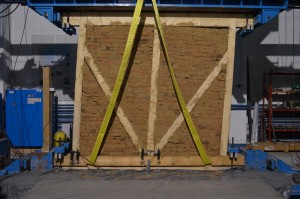TIMBER FRAMES WITH VARIOUS INFILLS (TFMRO project 2015-2017)
Based on the knowledge gathered by experimental studies in Portugal and Japan regarding foreign residential houses with timber frames and masonry infills (TFM), within the project the traditional Romanian residential houses with a structure made of timber posts and beams were investigated, infilled with different materials.
The project proposed an evaluation method of the shear capacity of timber frames structures with different types of infill when subjected to lateral load (earthquake or wind). For this purpose only the lateral load carrying wall within a certain type of structure (starting with timber frames with masonry infills – TFM) was considered and for it a shear spring model was developed and calibrated, based on the deformation capacity of each component that contributes to the behavior of a TFM building wall (timber connection, compression perpendicular to grain of posts and beams, bond-slip between bricks and mortar, masonry strut, etc). The shear spring model was able to simulate the shear capacity of a TFM wall (force and top displacement) within the building, and if used as for a macro-model, can be used to evaluate the seismic capacity of the entire building. This model can be calculated with easy to use commercial programs such as Excel.
A field study (in Vrancea seismic source area) highlighted the characteristic details (connection, layout of the timber elements, etc) of the Romanian timber frames and the different types of infills (masonry, clay, mud, etc).

Experimental tests on the materials, sub-assemblies and full scale wall of the most spread Romanian typologies (from the TFM category), helped to calibrate and validate the model. It was also used for other similar typologies.
The project was financially supported by the Romanian National Authority for Scientific Research and Innovation, CNCS – UEFISCDI, project number PN-II-RU-TE-2014-4-2169” between 2015 and 2017.
